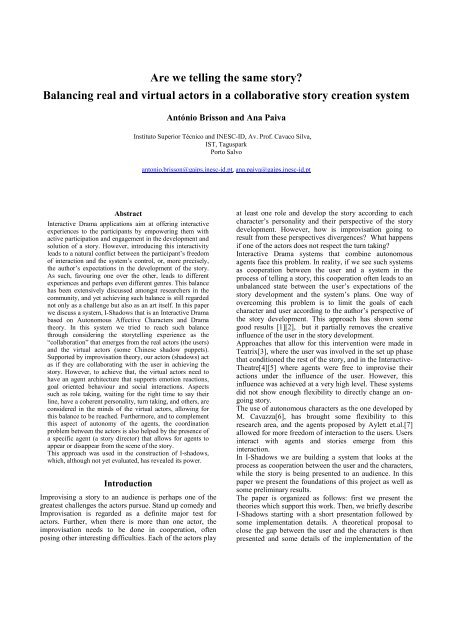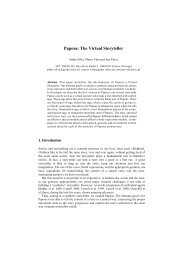Are we telling the same story? Balancing real and ... - ResearchGate
Are we telling the same story? Balancing real and ... - ResearchGate
Are we telling the same story? Balancing real and ... - ResearchGate
- No tags were found...
You also want an ePaper? Increase the reach of your titles
YUMPU automatically turns print PDFs into web optimized ePapers that Google loves.
Figure 8 - Princess RelationDirectorAs said before, <strong>the</strong> emergence of a <strong>story</strong> with severalautonomous entities, our cast <strong>and</strong> our users should result if<strong>the</strong> process of acting <strong>and</strong> reacting is collaborative inessence. For example, an agent waits for ano<strong>the</strong>r agent toperform its actions before it says its own line. This isguaranteed by <strong>the</strong> agent’s minds. Ho<strong>we</strong>ver, <strong>the</strong>re are o<strong>the</strong>relements in this collaborative process that are beyond <strong>the</strong>autonomous behaviours of <strong>the</strong> actors: for example, when acharacter from <strong>the</strong> cast is brought into scene. To controlsuch type of emergence <strong>we</strong> have developed a “directoragent” that controls <strong>the</strong> whole interactive process to keep<strong>the</strong> tension values proposed previously. Although it is stillbeing implemented, this component is responsible forcollecting all <strong>the</strong> affective information produced by <strong>the</strong>characters, specially focusing on <strong>the</strong> emotions of <strong>the</strong> hero<strong>and</strong> <strong>the</strong> victim. Based on this information <strong>and</strong> on itsknowledge about <strong>the</strong> characters’ relations, it choosesbet<strong>we</strong>en: sending a message to a character in <strong>the</strong> cast<strong>telling</strong> it to enter; sending a message to a character on <strong>the</strong>scene to leave; or not performing any action for <strong>the</strong>moment. The entrance <strong>and</strong> exit of characters will have anemotional impact on <strong>the</strong> characters’ relations, thusinfluencing <strong>the</strong> drama development. With studiesperformed with children collaborating in this <strong>story</strong>construction, this type of action (managing <strong>the</strong> appearance<strong>and</strong> disappearance of <strong>the</strong> characters) was very regularlyused. In <strong>the</strong> future <strong>we</strong> expect to augment <strong>the</strong> repertoire ofnarrative actions done by <strong>the</strong> Director.Preliminary ResultsSo far, <strong>we</strong> have shown how <strong>we</strong> approached <strong>the</strong>construction of a narrative drama application, where storiesemerge as a collaboration process bet<strong>we</strong>en <strong>the</strong> users <strong>and</strong><strong>the</strong> agents. To achieve that, <strong>we</strong> gave <strong>the</strong> agents a rich set ofbehaviours supported by an agent architecture that allowsfor affective <strong>and</strong> social behaviour.The authoring process of I-Shadows combined elements ofacting <strong>and</strong> fairy tales (by creating heroes, victims, orvillains) <strong>and</strong> of acting itself. As <strong>the</strong> system was designed asa close collaboration bet<strong>we</strong>en children <strong>and</strong> teachers, somegood results in terms of expression detection <strong>and</strong> emotionexpression <strong>we</strong>re achieved.The following example illustrates some elements of thisprocess, with an interaction bet<strong>we</strong>en a Princess <strong>and</strong> a Hero.Consider that <strong>the</strong> Princess loves <strong>the</strong> Hero with an intensitycorresponding to <strong>the</strong> initial value shown above. When shesees <strong>the</strong> Hero, a Show Love intention is activated by <strong>the</strong>Show Love meta goal (built into its mind).According to her emotional state, <strong>the</strong> Princess decides that<strong>the</strong> way of Showing Love for <strong>the</strong> hero is to offer him aC<strong>and</strong>y. This action generates a Joy emotion in <strong>the</strong> Herothat triggers a Smile.Figure 10 – Princess feels Hope of Showing LoveThe Hero’s smile is appraised by <strong>the</strong> Princess as a positiveaction. This appraisal has a positive impact on <strong>the</strong> relationwith <strong>the</strong> Hero. As a consequence, <strong>the</strong> next time <strong>the</strong>princess intends to show love she will consider a moreintense relation with <strong>the</strong> Hero that will activate a kissintention.Figure 9- The director influencing <strong>the</strong> cast
Figure 11 – Change in <strong>the</strong> Princess’s relationConclusionsThis paper argues that, to achieve interactivity ininteractive narrative systems, <strong>we</strong> can regard <strong>the</strong> <strong>story</strong>construction as a collaborative process bet<strong>we</strong>en users <strong>and</strong>characters. Ho<strong>we</strong>ver, for that to be possible, <strong>the</strong> charactersneed to have a role <strong>and</strong> be autonomous enough to decidewhat to do at a certain instant. In <strong>the</strong> paper, <strong>we</strong> havedescribed <strong>the</strong> construction of such type of autonomousagents using an emotional architecture based on FATiMa.This development was done in <strong>the</strong> context of <strong>the</strong> I-Shadows system, an interactive drama where <strong>the</strong> user isfree to act in <strong>the</strong> physical world by manipulating shadowpuppets.The stories created are a result of <strong>the</strong> actions of <strong>the</strong> user<strong>and</strong> <strong>the</strong> actions of autonomous characters. Fur<strong>the</strong>rmore,supported by <strong>the</strong>oretical groundings in interactive drama<strong>and</strong> <strong>the</strong> role that <strong>the</strong> proposed emotional model has inachieving interactivity, <strong>we</strong> have built a Director agent thatsomehow coordinates parts of this process (based on thatemotional model).Authoring characters using FATiMa is not easy due to <strong>the</strong>lack of a <strong>real</strong> methodical authoring approach for buildingagents for interactive narrative. A character-centredapproach needs to be follo<strong>we</strong>d, <strong>and</strong> that is often difficult todo. Characters are acting according to <strong>the</strong>ir roles <strong>and</strong> havedynamic relations, <strong>and</strong> it is <strong>the</strong>se roles <strong>and</strong> relations thatneed to be captured in <strong>the</strong> agents’ minds. Although <strong>the</strong>results are so far positive, <strong>we</strong> believe ho<strong>we</strong>ver that, to<strong>real</strong>ly obtain a good play, <strong>the</strong> characters need to be fur<strong>the</strong>rimproved. Moreover, <strong>we</strong> expect to start evaluating <strong>the</strong>system with children very soon <strong>and</strong> evaluate <strong>the</strong> degree ofcollaboration achieved bet<strong>we</strong>en <strong>the</strong> children <strong>and</strong> <strong>the</strong>system.Figure 12 – Hero’s emotional stateFigure 12 shows <strong>the</strong> actual hero’s emotional state afterfailing to defend a Victim. The hero was in a very positivemood because of <strong>the</strong> joy he felt when <strong>the</strong> victim expressedher love for him. Suddenly <strong>the</strong> villain hits <strong>the</strong> victim. Thehero appraised this event as a very negative action, <strong>and</strong> feltdisappointed, this appraisal generated resentment <strong>and</strong>reproach towards <strong>the</strong> action <strong>and</strong> towards his subject(Villain). As a consequence of <strong>the</strong>se events, his “Like”relation will decrease towards <strong>the</strong> villain <strong>and</strong> will increasetowards <strong>the</strong> victim. And because of this he will try toprotect <strong>the</strong> victim <strong>the</strong> next time. Figure 12 shows <strong>the</strong>hero’s emotional state after defending <strong>the</strong> victim. This time<strong>the</strong> hero succeeded in defending <strong>the</strong> victim <strong>and</strong> had apositive feeling of satisfaction.AcknowledgementsThis work is supported by <strong>the</strong> HUMAINE (Contract no.507422) project carried out with <strong>the</strong> provision of <strong>the</strong>European Community in <strong>the</strong> Framework VI Programme.The authors are solely responsible for <strong>the</strong> content of thispublication. It does not represent <strong>the</strong> opinion of <strong>the</strong>European Community <strong>and</strong> it is not responsible for any usethat might be made of data appearing <strong>the</strong>reinReferences[1] Riedl M., Saretto C.J,, Michael Young R. Managinginteraction bet<strong>we</strong>en users <strong>and</strong> agents in a multi-agent<strong>story</strong><strong>telling</strong> environment in Proceedings of <strong>the</strong> secondinternational joint conference on Autonomous agents <strong>and</strong>multiagent systems, AAMAS, 2003. Pp.: 741 – 748, 2003[2] Mateas M. <strong>and</strong> Stern A.: Towards integrating plot <strong>and</strong>character for interactive drama. In Socially IntelligentAgents: The Human in <strong>the</strong> Loop, AAAI symposium, 2000.
[3] Prada, R., Paiva, A., Machado, I., Gouveia, C. Youcannot use my broom! I’m <strong>the</strong> witch, you’re <strong>the</strong> prince:Collaboration in a Virtual Dramatic Game in proceedingsof ITS 2002, Springer 2002[4] Hayes-Roth, B., Sincoff, E., Brownston, L., Huard, R.,<strong>and</strong> Lent, B. Directed Improvisation. Stanford KnowledgeSystems Laboratory Report KSL-94-61, 1994.[5] Huard, R. D. <strong>and</strong> Hayes-Roth, B. Children's play withimprovisational puppets Stanford Knowledge SystemsLaboratory Report KSL-96-27, 1996.[6] Cavazza M., Charles F., Mead S. J. : Agents'Interaction in Virtual Story<strong>telling</strong>. IVA 2001: 156-170[7] Aylett, R. Aylett, R.S, Figueiredo, R; Louchart, S;Dias, J. <strong>and</strong> Paiva, A. (2006) Making it up as you go along- improvising stories for pedagogical purposes. In: Gratch,J; Young, M; Aylett, R; Ballin, D. <strong>and</strong> Olivier, P,( eds) 6thInternational Conference, IVA 2006, Springer, LNAI 4133,pp 307-315[8] Murray J.: Hamlet on <strong>the</strong> Holodeck The MIT Press(August 27, 1998)[9] M. Mateas. A Preliminary Poetics for InteractiveDrama <strong>and</strong> Games. Contributions to First Person: NewMedia as Story, Performance, <strong>and</strong> Game, re-published atElectronic Book Review, 2001[10] Mateas M. <strong>and</strong> Stern A.; Façade’s <strong>we</strong>bsite,http://interactive<strong>story</strong>.net/[11]Spolin V.: Improvisation for <strong>the</strong> Theatre, North<strong>we</strong>sternuniversity Press, Evanston, Illinois Third Edition 1999[12]Johnstone, K.: Impro: improvisation <strong>and</strong> <strong>the</strong> <strong>the</strong>atre.New York: Theatre Arts Books.1979 ISBN 0-87830-117-8[13] Wikipedia: Freytag Pyramid,http://en.wikipedia.org/wiki/Freytag%27s_pyramidaccessed: 05/02/07[14]Propp V.: Morphology of <strong>the</strong> Folktale University ofTexas Press; 2 edition (June 1968) ISBN: 978-0-292-78376-8[15] Dias J. <strong>and</strong> Paiva A.: 2005, Feeling <strong>and</strong> reasoning: Acomputational model for emotional characters. Proceedingsof EPIA 2005, 127-140, Springer, LNCS, 2005.[16] Brisson A., Fern<strong>and</strong>es M., Paiva A.: Children asAffective Designers HUMAINE WP9 workshop, Kista,S<strong>we</strong>den 2006.






